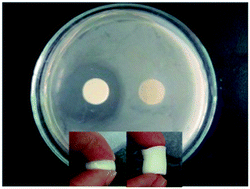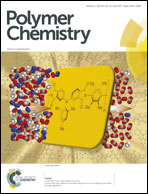Macroporous antibacterial hydrogels with tunable pore structures fabricated by using Pickering high internal phase emulsions as templates
Abstract
Artemisia argyi oil (AAO)-loaded macroporous antibacterial hydrogels were prepared by polymerization of oil-in-water Pickering high internal phase emulsions (HIPEs). The HIPEs were stabilized by the synergy of hydrophilic silica nanoparticles (N20) and surfactant Tween 80. The void interconnectivity and pore size of the hydrogels could be tailored readily by varying the concentrations of N20 nanoparticles and Tween 80. The mechanical properties of the porous hydrogels were related to the pore structure of the materials. There was an optimal condition for the N20 particle and Tween 80 contents where the hydrogel exhibited high compressive stress and strain. The in vitro release of the AAO-loaded hydrogels with different inner morphologies was evaluated and showed controlled release activity. The antibacterial activity of the AAO-loaded hydrogel was evaluated against Staphylococcus aureus and Escherichia coli. This kind of hydrogel exhibited excellent and long-term antibacterial activity indicating its potential use in biomedical and infection prevention applications.


 Please wait while we load your content...
Please wait while we load your content...